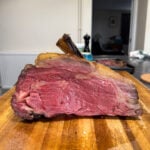Slow Roasted Prime Rib (Reverse Seared)
Here's how to reverse sear a prime rib roast that's melt in your mouth tender & pink from edge to edge! This is an easy yet impressive centre piece to serve at Thanksgiving & Christmas.
Servings: 8 People
Equipment
- Roasting Tin (With A Rack)
- Digital Food Probe
- Butcher's Twine
Ingredients
- 2½ kg Bone In Prime Rib (See Notes)
- 2½ tsp Table Salt
- Fine Sea Salt
- Freshly Cracked Black Pepper
Instructions
Dry Brining The Prime Rib
- Pat your prime rib dry with kitchen paper then sprinkle the table salt all over the meat. Place the beef onto a rack set on a baking tray then chill in the fridge for 24-48 hours. Make sure to face the prime rib fat side up.
Cooking
- Take the prime rib out of the fridge, place fat side up onto a rack set inside a roasting tin then leave to sit at room temperature for at least 1 hour.
- In the meantime, preheat an oven to 100°c/80°c fan (212°f/176°f).If your oven doesn't go this low, set it as low as it will go!
- Next, pat the meat dry then generously season with freshly cracked black pepper plus extra sea salt if you like. Place into the preheated oven then slow roast until the internal temperature of the beef reaches 52°c/125°f. This will roughly take 2½-3 hours.As prime ribs tend to be quite tall, the top of the roast will probably be quite close to the top of your oven. I'd recommend flipping the beef over every 45 minutes or so, so that the rib cap doesn't over cook. This is for medium rare, which is how I think prime rib is best cooked. Feel free to cook your prime rib more/less if you'd prefer though. There's a temperature guide in the post above! As we dry brined the beef, it won't need anymore salt, unless you prefer a saltier crust.
- Once up to temperature, take the beef out of the oven, cover loosely with foil then leave to rest for 1 - 1½ hours.
- Whilst your beef is resting, turn your oven up as high as it will go. In most ovens this will be around 260°c/500°f.
- Once your beef has rested, remove the foil then cook in the preheated oven for 6-8 minutes, until well seared.
- Transfer your beef to a chopping board then remove any string. Use a sharp knife to remove the bones then cut the meat into slices, season with sea salt & freshly cracked black pepper then serve.
Notes
1. To Cook In An Aga - Slow roast the beef in the simmering oven, on a grid shelf placed onto the floor. Sear the beef in the roasting oven. Place your roasting tin as high in the roasting oven as you can, without it touching the top.
2. Prime Rib - For this recipe, you'll need a bone in prime rib. This is sometimes called a rib of beef or a standing rib roast. I used a 2.5kg prime rib for this recipe, which will serve 6-8 people but as we're cooking to temperature, this method will work for any size prime rib.
For the best flavour, I'd recommend buying a prime rib with the rib bones still attached. A prime rib roast will have between 2 - 7 bones attached, depending on the size of the roast. As a general guide, you should allow one bone per 2-3 people or 1 lb (450 grams) of bone in prime rib per person.
If your prime rib has the chine bone/plate bone on the bottom, I'd recommend removing this for easier carving. You'll need a butchery saw to do this though, so it'll probably be easier to ask your butcher to do this for you. However most prime ribs will have this removed already! There's a full guide to trimming a prime rib in the post above. I like to tie prime rib with butcher's twine so that it hold its' shape but this is optional. You could ask your butcher to do this for you as well.
3. Salt For Dry Brining - If you're in the US, I'd recommend swapping the table salt for the dry brine to Kosher salt & use ¾ tsp per lb of bone in prime rib. If you're in another country & would rather not use table salt, I'd recommend using a fine sea salt like Maldon salt.
4. Internal Temperatures – In my opinion, prime rib is best served medium rare, which is what we’re doing in this recipe. Feel free to cook your beef for longer, if you’d prefer. If you’re using a larger joint of beef, keep in mind that it will take longer to cook.
Here’s a guide to what internal temperatures to follow, for each cooking method (you’ll need a food probe). These are the temperatures to cook the beef to, the temperature will rise by a few degrees as the beef rests.
Rare: 46°c/115°f Medium Rare: 52°c/125°f Medium: 58°c/136°f Medium Well: 63°c/145°f Well Done: 68°c/154°f
5. Resting – Make sure to rest your beef for at least 30 minutes or up to 1½ hours, loosely covered in foil, before searing.
6. Leftovers – Any leftover roast beef should be stored in the fridge & will keep for up to 3 days. Leftovers can be served cold or reheated in the oven (in gravy is best!).
